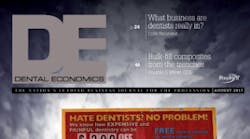Over the years, I have successfully implemented new technologies into my practice and have written extensively on the subject. I have covered both the benefits and challenges of integration, and handling the influx of new workflows into an established system. However, I only recently considered the role of technology as a “barrier” between the dentist and the patient.
I became aware of this topic in a conversation with one of my patients, a prominent orthopedic surgeon, while we were marveling at the same-day restoration I had just created for him with my Planmeca PlanScan CAD/CAM system. He could see the preparation, design, and milling of his crown on the screen in front of him, and no adjustments were needed, which spoke to the technology’s accuracy. He mentioned a similar technology used in preparing for joint replacement surgery, in which templates are designed and modeled to fit over certain bones and joints. With these advancements in mind, we discussed how technology is an integral part of our patient care. Yet it raised the question about whether we are looking at the computer screens more than we are looking at our patients. This resonated with me, as I often find myself engaged with the computer monitor - located behind the patient - while conducting my consultation.
While technology has had a positive impact on dental care, there is always the concern that advancements create a barrier between the dentist and the patient, which is the opposite of our intention. However, when the rising use of technology is examined, it can be argued that its positive effects far outweigh any negative effects, and that it breaks down old barriers rather than erects new ones.
Technological prestige: Technology now represents cleanliness, reliability, and progress. Patients associate these attributes with a modern-day dental practice. Along these lines, our office has phased out paper charts, x-ray film, impression material, and stone models, replacing them with digital records and 2-D/3-D images that are uncluttered, secured, and match that same positive image now associated with technology. Our physical offices have compact, sleek technologies that put the modern patient at ease, all while assisting us in providing the best care possible.
Technological competence: An up-to-date office that employs the latest technology is a statement that the dentist is staying in step with the newest advances, continually learning rather than relying on outdated knowledge or machinery. This helps inspire confidence in new patients, who will often say that they left their last dentist because of outdated equipment or a lack of reliability. The patient comes to us because we are experts in our field, and using the latest technologies helps assure them that we are committed to fulfilling that role.
Technological benefits: Technology has legitimate and tangible benefits that can be explained to patients and seen in treatment results. Improved diagnostics through higher resolution radiographs - at significantly lower radiation exposure to the patient - is just an example, as are better fitting restorations that can be delivered to the patient in a matter of hours, rather than weeks. Many patients may recognize how technology benefits them in these ways. Through explanation, other patients can be shown how these technologies help ensure top-tier dental care, using them as motivational tools to better connect to the patient and inspire confidence.
Technological connectivity: Technology is also tied to communication, and many patients now feel connected via the use of technology. Being able to stay in touch with our patients via text and e-mails, particularly with automatically generated appointment reminders, improves compliance for patients as well as efficiency for the office. It also allows patients to connect with their dentist in an easy, accessible way, adding them to their social circle and gaining a familiarity that may have been more difficult without the aid of modern social media.
While technology is good for these reasons, the most important part of what we do is how we manage the dentist-patient relationship, and we should use these technologies to enhance that relationship. Being aware of the patient’s understanding of and attitude toward all of the technology that we bring into the operatory and the office, combined with our relationship with the patient, helps us ensure that we deliver peak care while maintaining a positive connection with our patients.
Have a question for Dr. Kaye? E-mail him at [email protected].
Gary Kaye, DDS, FAGD, is the founder of the New York Center for Digital Dentistry and has practiced in New York City since 1993. He is a graduate of the Columbia University College of Dental Medicine. Dr. Kaye consults with other dentists and dental manufacturers, and lectures on topics including ceramics, occlusion, and digital dentistry. He is on the guest faculty of Planmeca University in Dallas, Texas.






